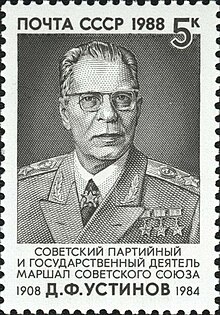Dmitriy Ustinov
| Dmitriy Ustinov Дмитрий Устинов |
|
|---|---|
 |
|
| Minister of Defence | |
|
In office 30 July 1976 – 20 December 1984 |
|
| Premier |
Alexei Kosygin Nikolai Tikhonov |
| Preceded by | Andrei Grechko |
| Succeeded by | Sergei Sokolov |
| First Deputy Chairman of the Council of Ministers | |
|
In office 13 March 1963 – 26 March 1965 |
|
| Premier |
Nikita Khrushchev Alexei Kosygin |
| Preceded by | Alexei Kosygin |
| Succeeded by | Kirill Mazurov |
| Full member of the 24th, 25th, 26th Politburo | |
|
In office 5 March 1976 – 20 December 1984 |
|
| Candidate member of the 20th–21st, 22nd, 23rd, 24th Politburo | |
|
In office 8 April 1966 – 5 March 1976 |
|
|
In office 25 March 1965 – 29 March 1966 |
|
| Member of the 22nd, 23rd, 24th, 25th Secretariat | |
|
In office 26 March 1965 – 26 October 1976 |
|
| Personal details | |
| Born |
17 October 1908 Samara, Russian Empire |
| Died | 20 December 1984 (aged 76) Moscow, Soviet Union |
| Nationality | Soviet |
| Political party | Communist Party of the Soviet Union |
| Profession | Mechanical engineer |
| Awards |
|
| Military service | |
| Allegiance |
|
| Service/branch | Soviet Armed Forces |
| Years of service | 1941–1984 |
| Rank | Marshal of the Soviet Union |
| Battles/wars | World War II |
Dmitriy Feodorovich Ustinov (Russian: Дми́трий Фёдорович Усти́нов; 30 October 1908 – 20 December 1984) was Minister of Defence of the Soviet Union from 1976 until his death.
Dimitry Feodorovich Ustinov was born in a working-class family in Samara. During the civil war, when hunger became intolerable, his sick father went to Samarkand, leaving Dimitry as head of the family. Shortly after that, in 1922, his father died. In 1923, he and his mother, Yevrosinya Martinovna, moved to the city of Makarev (near Ivanovo-Voznesensk) where he worked as a fitter in a paper mill. Shortly after that, in 1925, his mother died.
Ustinov joined the communist party in 1927. In 1929, he started training at the Faculty of Mechanics in the Polytechnic Institute of Ivanovo-Voznesensk. Afterward, Ustinov was transferred to the Moscow Bauman Higher Technical School. Then, in March 1932, he entered the Institute of Military Mechanical Engineering in Leningrad from where he graduated in 1934. Afterward, he worked as a construction engineer at the Leningrad artillery Marine Research Institute. In 1937, he was transferred to the "Bolshevik" Arms Factory as an engineer. He later became the director of the Factory.
At the time of the Nazi invasion of the Soviet Union, in June 1941, Stalin appointed the 32-year-old Ustinov to the post of People's Commissar of Armaments. From this position, he supervised the massive evacuation of the defence industry from the besieged city of Leningrad to east of the Ural Mountains. Over 80 military industries were evacuated that together employed over six hundred thousand workers, technicians, and engineers. Stalin later rewarded Ustinov, whom he called "the Red-head", with the Soviet Union's highest civilian honour, Hero of Socialist Labour. After the war was over, Ustinov played a crucial role in requisitioning the German missile programme, developed during World War II, as an impetus to the Soviet missile and space programmes.
...
Wikipedia
